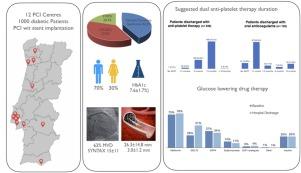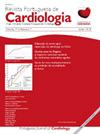Anti-thrombotic and glucose lowering therapy in diabetic patients with coronary artery disease undergoing PCI with stent implantation: A prospective multicenter observational study on prescription patterns and clinical outcomes. Baseline inclusion data of the ARTHEMIS registry
IF 1.6
4区 医学
Q3 CARDIAC & CARDIOVASCULAR SYSTEMS
引用次数: 0
Abstract
Introduction and objectives
Diabetes is a major determinant of ischemic events after percutaneous coronary intervention (PCI). In a nationwide prospective registry, antiplatelet and glucose-lowering treatment regimens, and two-year clinical outcomes were studied in unselected patients with type 2 diabetes undergoing coronary stent implantation. The current analysis describes the population's baseline characteristics and the prescription patterns of anti-thrombotic and glucose-lowering drugs.
Methods
Between January and November 2021, 1000 patients were enrolled in 12 Portuguese hospitals. In addition to clinical and procedural-related variables, thrombotic (DAPT score) and bleeding risks (PRECISE DAPT) were estimated, and medication (including planned duration of dual antiplatelet therapy) were recorded.
Results
Inclusion rate was relatively high (68.6%) among all eligible patients during the study period (mean age 68±10 years-old, and 70% of male gender). The indication for PCI was an acute coronary syndrome in 58% of cases and 63% had 2–3 vessel coronary artery disease (SYNTAX score 15.6±10.7; mean stent length and diameter 26.3±14.8 and 3.0±1.2 mm, respectively). Of patients not on oral anticoagulation, only 49.8% received potent P2Y12 inhibitors; overall recommendation for shorter DAPT regimens (<6 months,) was 26.5% and did not differ according to low vs. high bleeding risk (24.6% vs. 29.7%; p<0.125). In those also under anticoagulation, 62.6% received a recommendation for <30-day regimens, or no DAPT at all (13.6%). Prolonged DAPT (>12 months) was planned at baseline in 0.7% of the whole cohort and 1.2% of ACS patients. PCI complexity (but not CAD extent) was associated with DAPT duration. Self-reported duration of diabetes was >6 years in 57% (HbA1c 7.6±1.7%) and 12% had known microangiopathy at inclusion. SGLT2 inhibitors (28%) and GLP-1 analogues (3%) were used seldom at admission.
Conclusions
Standard six-to-12-month antiplatelet regimens were the most widely used, largely with acetylsalicylic acid and clopidogrel. DAPT duration was mostly related to PCI complexity and oral-anticoagulation. Metabolic control was off-target and guideline-directed treatment for diabetes was underused at admission (clinicaltrials.gov NCT04481997).

冠心病糖尿病患者行PCI伴支架植入术的抗血栓和降血糖治疗:一项处方模式和临床结果的前瞻性多中心观察性研究
简介和目的:糖尿病是经皮冠状动脉介入治疗(PCI)后缺血性事件的主要决定因素。在一项全国范围的前瞻性登记中,研究了未经选择的接受冠状动脉支架植入术的2型糖尿病患者的抗血小板和降血糖治疗方案以及两年的临床结果。目前的分析描述了人群的基线特征和抗血栓和降血糖药物的处方模式。方法:2021年1月至11月,在葡萄牙12家医院招募了1000名患者。除了临床和手术相关的变量外,还评估了血栓形成(DAPT评分)和出血风险(PRECISE DAPT),并记录了药物治疗(包括计划的双重抗血小板治疗持续时间)。结果:研究期间所有符合条件的患者(平均年龄68±10岁,男性占70%)纳入率较高(68.6%)。58%的病例的PCI指征是急性冠状动脉综合征,63%的病例有2-3支冠状动脉疾病(SYNTAX评分15.6±10.7;平均支架长度和直径分别为26.3±14.8和3.0±1.2 mm)。在未接受口服抗凝治疗的患者中,只有49.8%的患者接受了强效P2Y12抑制剂治疗;0.7%的整个队列和1.2%的ACS患者在基线时计划推荐较短的DAPT方案(12个月)。PCI复杂性(而非CAD程度)与DAPT持续时间相关。57%的患者(HbA1c为7.6±1.7%)自我报告的糖尿病病程为bb0.6年,12%的患者在纳入时已知有微血管病变。入院时很少使用SGLT2抑制剂(28%)和GLP-1类似物(3%)。结论:标准的6 -12个月抗血小板方案使用最广泛,主要是乙酰水杨酸和氯吡格雷。DAPT持续时间主要与PCI复杂性和口服抗凝有关。入院时,代谢控制偏离目标,指南指导的糖尿病治疗未得到充分利用(clinicaltrials.gov NCT04481997)。
本文章由计算机程序翻译,如有差异,请以英文原文为准。
求助全文
约1分钟内获得全文
求助全文
来源期刊

Revista Portuguesa De Cardiologia
CARDIAC & CARDIOVASCULAR SYSTEMS-
CiteScore
2.70
自引率
22.20%
发文量
205
审稿时长
54 days
期刊介绍:
The Portuguese Journal of Cardiology, the official journal of the Portuguese Society of Cardiology, was founded in 1982 with the aim of keeping Portuguese cardiologists informed through the publication of scientific articles on areas such as arrhythmology and electrophysiology, cardiovascular surgery, intensive care, coronary artery disease, cardiovascular imaging, hypertension, heart failure and cardiovascular prevention. The Journal is a monthly publication with high standards of quality in terms of scientific content and production. Since 1999 it has been published in English as well as Portuguese, which has widened its readership abroad. It is distributed to all members of the Portuguese Societies of Cardiology, Internal Medicine, Pneumology and Cardiothoracic Surgery, as well as to leading non-Portuguese cardiologists and to virtually all cardiology societies worldwide. It has been referred in Medline since 1987.
 求助内容:
求助内容: 应助结果提醒方式:
应助结果提醒方式:


